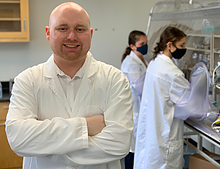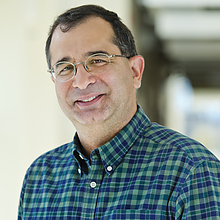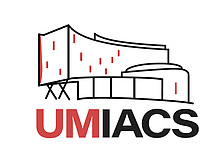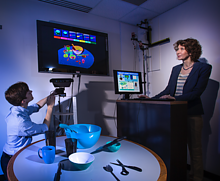All News
Former CBCB Graduate Student Receives Larry S. Davis Doctoral Dissertation Award
A former graduate student in the Center for Bioinformatics and Computational Biology (CBCB) has been recognized for the excellence of her academic work on developing practical and efficient solutions to index large collections of genomes.
Fatemeh Almodaresi, who graduated with a Ph.D. in computer science in Summer 2020, is one of two students to receive the Larry S. Davis Doctoral Dissertation Award this year.
The annual award recognizes outstanding doctoral dissertations in the Department of Computer Science that convey excellence in their technical depth, significance, potential impact and presentation quality.
The award is named for Larry Davis, a Distinguished University Professor of computer science who served as chair of the department from 1999–2012. Davis was also the founding director of the University of Maryland Institute for Advanced Computer Studies (UMIACS), providing leadership for the institute from 1985–1994.
Her UMD dissertation, “Algorithms and Data Structures Indexing, Querying, and Analyzing Large Collections of Sequencing Data in the Presence or Absence of a Reference,” covers the development of new data structures as well as innovative, practical and efficient solutions to indexing large collections of genomes.
“Fatemeh demonstrates both technical brilliance and the ability to come up with ideas that are theoretically interesting and of tremendous practical impact,” says Rob Patro, an associate professor of computer science who advised Almodaresi during her doctoral studies.
In recommending her for the Davis dissertation award, Patro noted Almodaresi’s design of a new compacted version of a De Bruijn graph, a data structure that is used in bioinformatics to assemble and analyze genomes. Although similar structures have previously been proposed, Almodaresi’s work greatly improved the practicality and efficiency in important ways, Patro explains.
In recommending her for the dissertation award, Patro noted Almodaresi’s design of a new compacted version of a De Bruijn graph, a data structure that is used in bioinformatics to assemble and analyze genomes. Although similar structures have previously been proposed, Almodaresi’s work greatly improved the practicality and efficiency in important ways, Patro explains.
Almodaresi also built a tool using her new data structure for the taxonomic assignment of metagenomic read data, a well-studied problem in the field of computational biology. The taxonomic classifier she designed is both more accurate and more efficient—requiring less memory while operating at a similar speed—than two popular tools that are widely-used to accomplish the same task, Patro says.
One major goal in the field is to build practical indexes on the hundreds of thousands of sequencing samples available in public data repositories. In pursuit of this idea, Almodaresi developed new methods and solutions to perform large-scale search of raw sequencing data using a system called Mantis. Her methods allow the index to be iteratively updated–a crucial feature as the amount of genomic data to be indexed continues to grow.
“I anticipate that much of the theory and methodology Fatemeh develops will have a far-reaching impact both within and beyond the field of genomics,” says Patro. “She is a truly expectational researcher—displaying an intelligence, commitment and real passion at a level that I find to be rare, even among top Ph.D. students.”
—Story by Maria Herd
Dr. Rita Colwell Book "A Lab of One's Own - One Woman's Personal Journey Through Sexism in Science"

Understanding How the Gut Microbiome Influences Human Health

Living inside of every person are trillions of microorganisms—bacteria, viruses, fungi and other life forms that are collectively known as the microbiome. While they are miniscule in size, this collection of microbes has a big impact on our health.
Brantley Hall, who joined the University of Maryland on July 1 as an assistant professor in the Department of Cell Biology and Molecular Genetics, is particularly interested in the microbiome of the human gut, the region of the gastrointestinal tract that digests food, absorbs nutrients and expels waste.
Based on years of effort by numerous researchers focused on the microbiome, Hall says that scientists have collectively accumulated an acceptable understanding about the species of microbes that inhabit the gastrointestinal tracts of people in the United States.
The next step, he says—and one that will be the focus of his new lab at UMD— is to genetically interrogate the functions that these gut microbes perform, and how those functions interact, both positively and negatively, with human health.
“This is an enormous undertaking,” Hall explains. “There are millions of gut microbial genes lacking functional annotation, and those with functional annotations are of questionable quality.”
Hall says his lab is working to fill that gap by improving functional annotation across gut microbiome species, combining computational and wet-lab techniques to identify genes responsible for health-relevant functions, and developing new strategies to measure the metabolic output of the gut microbiome.
“Our long-term goal is to rationally modulate the human gut microbiome to improve human health,” he says.
Hall, who also has an appointment in the University of Maryland Institute for Advanced Computer Studies (UMIACS), says that coming to UMD seemed like a “very good fit.”
“I was excited about the opportunity to work with researchers at Maryland,” he says. “There is an enormous value in being surrounded by like-minded computational biologists.”
Michael Cummings, a professor of biology and director of Center for Bioinformatics and Computational Biology (CBCB)—one of five major centers that are part of UMIACS—says that Hall is a “very welcome addition” to the Maryland campus.
“Brantley’s interesting and important gut microbiome research is complementary to other research in CBCB, particularly that of [UMIACS director] Mihai Pop,” Cummings says.
Cummings adds that while still early in his career, Hall has proven to be extremely productive as evidenced by his publication record, noting that his research is also impactful, as evidenced by the citations his publications have garnered.
Hall says he has already learned a great deal from his interactions with researchers at CBCB. He cites recent collaborations with Pop and Rob Patro, an associate professor of computer science, as examples.
“By co-advising a graduate student with Mihai, I have been able to draw on his extensive expertise in metagenomic assembly to improve our computational experiments,” Hall says. “And close interactions with genomic software developers such as Rob gives us a better understanding of the state-of-the-art techniques in tool development.”
He adds that UMIACS’ computational resources have already proven beneficial to his research. Specifically, he says his lab is analyzing thousands of metagenomes, which takes a great amount of space to store and a lot of CPU cores to analyze.
“When I was interviewing at UMD, several professors emphasized how great the computing facilities were, and I can now attest that this is true,” Hall says. “Setting up and maintaining these large computing clusters isn't always easy to pull off, and I am grateful for the UMIACS tech support on both the hardware and software.”
—Story by Melissa Brachfeld
Patro Works to Improve Search Functionality for Large Repositories of Sequencing Data

Genomic sequencing data can often shed light on a wide array of scientific problems—from treating patients with heart disease and cancer to understanding how certain pathogens can affect plants and animals.
Public repositories of genomic data are becoming more commonplace and are growing at an exponential rate. The National Center for Biotechnology Information (NCBI), for example, runs the Sequence Read Archive (SRA), a repository that holds raw scientific data for a vast number of scientific experiments conducted using high-throughput sequencing data.
While repositories like the SRA are a boon to researchers, the ability to quickly search these large public databases for a specific sequence of interest is limited.
To that end, Rob Patro (in photo), an associate professor of computer science, is leading an effort to develop fundamentally improved data structures and algorithms to enable large-scale sequence search across public repositories of genomic data.
Patro is collaborating on this work with Mike Ferdman and Michael Bender, both at Stony Brook University, and Rob Johnson, a senior staff researcher at VMWare Research group.
Patro says that making these types of databases easier to search can help researchers get to the bottom of unique problems.
“Imagine a scientist who discovers what they imagine to be a novel environmental pathogen that, perhaps, has a negative effect on plant or animal health,” he says. “It may be very useful to know what other previously-collected data might have contained this pathogen, but its presence was not reported because the scientists working on the previous studies were focused on a different question and did not take note of this new pathogen. Combing through the repository of available data might help us learn more about this pathogen.”
Patro says that the technical challenge in addressing such a problem is simply the scale of the data. The SRA, for example, currently contains about 16 petabytes of data.
Sequencing data is quite different from other domains where similar challenges have been tackled, he adds.
“DNA and RNA do not have a well-defined vocabulary of words or ‘tokens’ into which the data can be broken down,” he says. “So it’s very different from a typical internet search query.”
Patro’s research group has recently been working on data structures and algorithms that let them scale sequence indices to increasingly large sets of experiments, while enabling very fast (approaching interactive) queries.
A recent paper they authored introduced a fundamentally better scheme for storing and retrieving a key component of this information than their previous attempts. (Note: the lead author on the paper was Fatemeh Almodaresi, who just completed her doctoral degree at UMD with Patro as her adviser.)
The researchers discovered that by examining the patterns of occurrence of small pieces of DNA in the repository—and compressing similar, rather than just identical, patterns in a relative manner—they could reduce the size of this component of the data structure by over an order of magnitude, without slowing the query speed, and, in some cases, speeding it up.
“A main technical challenge here is how one can efficiently search for ‘similar’ patterns when each pattern consists of a point in a very high dimensional space,” Patro says. “While initial attempts to solve this problem using a technique known as locality-sensitive hashing seemed not to work well, we were able to exploit the inherent structure of the data, and take advantage of a widely-used structure in genomics—known as the De Bruijn graph—to develop an efficient search structure to find ‘similar’ patterns efficiently.”
Patro’s group continues to work on this problem, providing important improvements to the indexing methodology. Additionally, they have redesigned the largest part of the index, which was previously required to be in the Random Access Memory (RAM) of the computer to be intelligently partitioned. This allows them to load only small parts of the index at a time, vastly reducing the amount of memory required to both build and query the index.
Finally, they are developing a distributed variant of this index that can be partitioned across a network of machines, allowing the query procedure to be scaled up simply by adding more machines to the network and improving robustness.
—Story by Melissa Brachfeld
***
Note: Patro was recently promoted to associate professor. In addition to his tenure appointment, he has an appointment in the University of Maryland Institute for Advanced Computer Studies, where he is a member of the Center for Bioinformatics and Computational Biology.
El-Sayed Named Director of Honors College Integrated Life Sciences Program

Najib El-Sayed, a professor of cell biology and molecular genetics, has been named director of the Integrated Life Sciences (ILS) program at the University of Maryland.
The program, part of the university’s Honors College, offers talented undergraduates a biologically-inspired living and learning experience that includes a significant research requirement.
Many ILS graduates go on to graduate school and careers in medicine (both human and veterinary), public health, dentistry, and academia.
El-Sayed, who has an appointment in the University of Maryland Institute for Advanced Computer Studies, is an expert on the biology of parasitism and host-pathogen interactions using genomic and bioinformatics approaches.
He is the author of more than 80 research articles and book chapters and was designated as a highly cited investigator in microbiology by Thomson Reuters.
Go here to see an overview of El-Sayed’s research interests.
Cummings Receives NSF Funding to Improve Analyses of COVID-19 Genomic Data
A University of Maryland computational biologist has received funding from the National Science Foundation (NSF) to develop new tools and strategies for analyzing genomic data from severe acute respiratory syndrome coronavirus 2 (SARS-CoV-2), the strain of coronavirus responsible for COVID-19.
Michael Cummings, a professor of biology with an appointment in the University of Maryland Institute for Advanced Computer Studies (UMIACS) is primary investigator of the $188K award. The funding comes from the NSF Rapid Response Research initiative, which aims to mobilize the scientific community in response to the current pandemic.
A major goal of the project, Cummings says, is to accelerate the analyses of SARS-CoV-2 genomic data needed by scientists and public health officials battling the virus. “Evolutionary analyses using genomic data are an essential component of the scientific response to the COVID-19 pandemic,” he says.
Inferring the evolutionary history, or phylogeny, of virus samples—coupled with information on the time and location of where the samples originated—allows scientists to estimate the divergence of viral lineages, Cummings says. These types of analyses can provide time estimates that predate sampling events, meaning that public health officials could ostensibly predict where and when certain strains of SARS-CoV-2 could pop up next, and whether a strain of the virus has mutated from its last outbreak.
But current methods of analyzing these samples takes time. Even with powerful advances in computing power over the last decade, the process can require up to 150 hours or more to complete.
Cummings, working closely with Daniel Ayers, an assistant research scientist in UMIACS, plans to develop new software and parallel computing algorithms that could help decrease this timeline considerably.
The Maryland researchers are also working to improve the phylogenetic analyses of a certain type, referred to as molecular phylodynamics, which includes not only evolutionary history but also information on viral genetic variation and viral population dynamics—again all in the context of geography and time.
Phylodynamic analyses are particularly rich in terms of inferences, albeit at a considerable computational cost, Cummings says.
Ultimately, the research by Cummings and Ayers will offer a more comprehensive view of the transmission patterns for SARS-CoV-2. This includes defining patterns of SARS-CoV-2 movement and migration; identifying the specific timeline of an outbreak origin; determining the rate of mutation and detection of significant mutations with the resultant health impacts; identifying the prevalence of the virus in populations at different geographical scales; reproductive number and impact on policy; and infection-to-case reporting rates.
To increase the speed at which samples are sequenced and also to improve accuracy and decrease cost, Cummings and Ayers plan to work with others to develop more efficient parallel computing strategies and software, taking advantage of NSF-supported high-end computational resources at the Pittsburgh Supercomputing Center, San Diego Supercomputing Center, and the Texas Advanced Computing Center.
They will also rely upon open-source software they developed—known as BEAGLE, for Broad-platform Evolutionary Analysis General Likelihood Evaluator—that has become an essential component in the software workflow of many scientists studying the evolutionary history of organisms, including the viruses that cause AIDS, influenza and Ebola.
“BEAGLE is used in a variety of studies that contribute to our understanding of evolution and biology, which can have a role in informing decision-making,” Ayres says. “Now there are dozens, if not hundreds, of scientists worldwide using BEAGLE to better understand SARS-CoV-2.”
Though Cummings has been active with research for more than a decade on other serious public health issues, the speed and strength by which the current COVID-19 pandemic has spread has given him pause for thought, and also bolstered his resolve to help find answers.
“Science is a privilege, and we are given multiple opportunities to give back—we write papers and we educate students,” he says. “But now there is an opportunity to use the ideas and tools we’ve been working on for quite a while to have a positive impact on the current crisis. It gives us the incentive to work as hard as we possibly can.”
—Story by Tom Ventsias
Five UMIACS Faculty Receive Academic Promotions

In recognition of their continued excellence in research, scholarship and service, five faculty members in the University of Maryland Institute for Advanced Computer Studies (UMIACS) have received academic promotions from their respective departments.
Marine Carpuat (computer science), Vanessa Frias-Martinez (iSchool), Michelle Mazurek (computer science), Rob Patro (computer science), and Dana Dachman-Soled (electrical and computer engineering) have each been promoted from assistant professor to associate professor with tenure.
The academic promotions for Carpuat, Mazurek, Patro and Dachman-Soled are effective on July 1; the promotion for Frias-Martinez takes place in August.
“Marine, Vanessa, Michelle, Rob and Dana are all known for their outstanding research and strong commitment toward educating and mentoring students. They are a tremendous asset to our institute, their home departments, and the university as a whole,” says Mihai Pop, professor of computer science and director of UMIACS.
Carpuat’s research in the Computational Linguistics and Information Processing (CLIP) Lab focuses on multilingual natural language processing and statistical machine translation. She designs computational models that use second languages as meaningful annotation to make language processing applications more accurate, robust and useful.
Frias-Martinez is also a member of the CLIP Lab and does the majority of her research in her own Urban Computing Lab. The focus of her work is on building mathematical models that explain human behavior. This includes examining human interaction with the built-in environment in cities, and how those interactions might change due to events like natural disasters, economic crises or forced migrations.
Patro’s research in the Center for Bioinformatics and Computational Biology (CBCB) focuses on the design of algorithms and data structures for processing, organizing, indexing and querying high-throughput genomics data. His interests also extend to programming languages, computer graphics, scientific visualization, parallel computation and machine learning.
Both Mazurek and Dachman-Soled are core faculty members in the Maryland Cybersecurity Center (MC2).
Mazurek’s research focuses on human-centered computer security, understanding and influencing security and privacy behaviors and preferences by collecting real data from real users. Her recent work includes making security easier for professionals such as system administrators and software developers, understanding how and why end-users learn and apply security behaviors, and investigating adoption of end-to-end encrypted messaging.
Dachman-Soled research involves cryptography, complexity theory and security. This includes security against physical attacks, post-quantum cryptography, secure multiparty computation, and black-box complexity. Her research also extends to property testing of Boolean functions and cryptographic hardness of learning.
UMIACS Faculty Adapting to Online-Only Research Activities During COVID-19 Crisis

The normal whirlwind of hands-on research activity inside the Brendan Iribe Center for Computer Science and Engineering has come to a screeching halt.
The 215,000-square-foot-facility—home to the Department of Computer Science and the University of Maryland Institute for Advanced Computer Studies (UMIACS)—is empty these days, the result of severe research restrictions that have barred access to the Maryland campus for all but a handful of essential personnel.
While computer science faculty are busy teaching online during the current COVID-19 health crisis, UMIACS researchers—80-plus faculty from eight departments and almost 200 graduate students—are also using online resources to advance research in robotics, computational biology, cybersecurity, and more.
Cornelia Fermüller (right in photo), an associate research scientist in UMIACS, says the biggest challenge for her team has been losing access to specialized hardware in their robotics lab.
Fermüller says her students continue working on their ongoing projects, but that many wish to be back in the lab, “getting their hands on the data and running experiments with the robots in real time.”
An example of her team’s current workaround model involves a robotic hand used to explore how tactile sensing works in active tasks like grasping, pushing and pulling. Without access to their lab that houses a robotic arm they use, the researchers are relegated to analyzing previously collected sensor data and developing models and algorithms in order to understand the robot’s hand movements.
“We’re looking at the sensor characteristics, and modeling the relationship between forces applied to the tactile sensor and its readings,” Fermüller says. “We’re also investigating how to robustly process the tactile data from the sensors in an event-based way.”
Tudor Dumitraș, an associate professor of electrical and computer engineering in the Maryland Cybersecurity Center, says the shift to an all-online environment has made parts of the research process more challenging for his team.
“While we can run the same experiments that we were running before, the disruption has been dramatic, owing to the challenges for teamwork raised by the online environment,” Dumitraș says. “I've significantly lowered my expectations for my group's research productivity this year, and I am very impressed that some of my students are able to stay motivated and can continue making progress.”
Moreover, his team often requires large-scale computational resources to run their analyses, which might become more difficult as a result of the restrictions.
“Normally, the UMIACS tech staff can meet our requirements quickly, but with the restricted access, if we request that new equipment be installed or current equipment upgraded, it may take them a bit longer,” Dumitraș says.
He called this a minor issue, however, saying his group is more concerned with the loss of regular in-person meetings—a “key part of the process” for their research projects.
“Each one of us can bring a new perspective to a problem, so it’s important for us to interact on a regular basis,” Dumitraș says. “This type of brainstorming is much harder to replicate online, although we’re trying.”
The research restrictions have also put a hold on a summer research internship program that Dumitraș has run for the past three years. The program brings up to a dozen top undergraduates from universities overseas, focusing on underrepresented groups like female researchers and students from universities in Eastern Europe.
“The process of preparing those [summer] research projects is a key part of training for my current graduate students, because they have to formulate a project and supervise the interns once they’re here,” Dumitraș says. “The internship program is also a good pipeline for getting top-notch students to apply here for graduate school, and it was a lot of fun.”
Mihai Pop, a professor of computer science and the director of UMIACS, says the loss of onsite access for his lab’s workgroup hasn’t deterred their passion for using computational biology to explore the genetic makeup of microbial communities.
“Most of our work essentially is just sitting on a computer doing analyses of genetic data,” says Pop.
Still, Pop echoes Dumitraș in saying that what has been most taxing is the loss of personal connections.
“The main thing that’s lost is the interaction and being able to just walk up to somebody’s desk and bounce ideas off of them,” Pop says. “Those kinds of informal, personal interactions do add a lot to the graduate student experience, and we’ll work hard to rebuild those activities once we’re back on campus.”
—Story by Colleen Curran
UMIACS Faculty Secure Funding for Projects Combining AI and Medicine

Three faculty members in the University of Maryland Institute for Advanced Computer Studies (UMIACS) have received funding to jumpstart research that combines powerful artificial intelligence tools with medical expertise in areas like aging, traumatic brain injury, mental illness, and more.
Michael Cummings, a professor of biology and director of the Center for Bioinformatics and Computational Biology, Philip Resnik, a professor of linguistics, and John Dickerson, an assistant professor of computer science, are involved with two of the four projects recently funded under a new initiative known as AI + Medicine for High Impact (AIM-HI).
The program—which joins faculty from the University of Maryland, College Park, with medical experts at the University of Maryland, Baltimore—provides up to $200K per year for each project, for a maximum of three years.
Officials hope that these cross-institutional efforts will lead to lead to scientific breakthroughs with the potential to secure larger federal awards as the research progresses.
“There is tremendous promise in each of the awards to attract additional external funding while making an impact to the state and region,” says Eric Chapman, the associate vice president for research development at the University of Maryland, College Park. “By leveraging our complementary cross-campus expertise, the state of Maryland will be able to tackle major health issues of societal importance.”
Cummings will work with experts in pharmaceutical sciences and anesthesiology at UMB to study aging and traumatic brain injury in mice. The researchers will develop an analytical framework to identify predictive functional relationships between changes in different metabolic parameters during aging.
The ultimate goal, Cummings says, is to generate testable hypotheses about mechanisms contributing to aging under both normal and disease conditions, which could lead to identification of appropriate interventions.
The researchers hope to transfer their initial findings to similar conditions seen in humans, which might eventually contribute toward treatments for age-related diseases like dementia and Alzheimer’s.
Resnik and Dickerson are partnering with Carol Espy-Wilson, a professor of electrical and computer engineering at UMD, and psychiatric experts at the School of Medicine in Baltimore lead by professor Deanna Kelly. The group is developing machine learning algorithms that can help assess mental illness online.
The goal of the project, Resnik says, is to establish a novel technological framework that integrates speech, video and text analysis in order to identify, assess and prioritize at-risk individuals.
The team’s initial research will focus on schizophrenia, major depressive disorder, and suicidal behaviors, but ultimately, they aim to develop a framework that can be broadly applied in other areas of healthcare.
–Story by Maria Herd
UMD Part of $10M NSF Expeditions in Computing Award to Develop Strategies to Thwart Disease Outbreaks

University of Maryland computing experts are partnering with a consortium of scientists from across the U.S. to deploy the latest advances in artificial intelligence, machine learning, supercomputing and social science data against epidemic outbreaks.
Funded by a $10 million grant from the National Science Foundation (NSF), the researchers are using these powerful technologies and tools to explore trends in globalization, anti-microbial resistance, urbanization and ecological pressures—factors that have converged to increase the risk of global pandemics like the COVID-19 crisis now wreaking havoc on populations and economies worldwide.
Professor Aravind Srinivasan, Distinguished University Professor Rita Colwell and Assistant Professor Abhinav Bhatele join faculty from 10 other universities on the Global Pervasive Computational Epidemiology project, which includes researchers from Princeton University, Yale University, Stanford University, the Massachusetts Institute of Technology and the University of Virginia, which is leading the multidisciplinary effort.
All three Maryland faculty have appointments in the University of Maryland Institute for Advanced Computer Studies.
While the concept of using modern technology to address the spread of global disease is not new, NSF officials said the launch last month of this project could not have come at a more opportune time.
“We are currently experiencing unprecedented access to massive data, powerful advanced computing capabilities, and models and simulations that can capture the complexity of viruses and associated diseases in ways that weren’t possible as recently as a decade ago,” said Mitra Basu, who leads the NSF’s Expeditions in Computing Program that provided funding for the five-year project. “Together with the incredible number of researchers who have turned their attention to COVID-19 and pandemics more generally, we are likely witnessing transformational efforts that can help with the current crisis, and allow us to be much better equipped for the next pandemic.”
Srinivasan is leading the computational foundations part of the project. Key to this work, he said, is the development of new machine learning algorithms that can interpret large amounts of data from multiple sources over multiple networks. This could include climate data interspersed with disease vector factors—how a virus spreads over time and distance—which is then compiled with the demographics of people who have tested positive for the virus.
The technology can also be used for interpreting dense social-contact networks—a complex “who knows who” pyramid that often determines how far and fast a virus will spread.
“Artificial intelligence and machine learning can play a role when we’re only able to collect fairly sparse real-time data,” Srinivasan said. “Using this limited data, we can build models of where and when we see infections spreading the most, allowing public health experts to make intelligent predictions of what to do tomorrow and the day after.”
These machine learning models can be especially important for policymakers, Srinivasan added, who will need to separate valid information from misinformation regarding the size and scope of a pandemic.
Colwell, who has spent much of her career using technology to combat waterborne diseases like cholera, is expected to work closely with other scientists on the effects that climate may have on the spread of viruses. She will also offer public policy advice, working with researchers at the Center for Disease Dynamics, Economics and Policy, a public health organization located in Washington, D.C.
Srinivasan said that both he and Bhatele will collaborate with other scientists on tasks that require high-performance computing for large-scale simulations. This could include “percolation properties” of how a disease might spread through the air, taking into account multiple factors like climate, urban environments and social demographics.
Government supercomputers located at the Lawrence Livermore National Laboratory in California and the Oak Ridge National Laboratory in Tennessee will assist with these simulations, Srinivasan said.
He said he was “humbled” to be one of the thousands of scientists worldwide thrust into the fight against a gobal pandemic just as the NSF project—under development well before COVID-19 was identified—was getting started.
“We expect that our work can have an immediate impact, but are also aware that the computational tools and policies we develop now can have an effect on future events like this,” he said. “That’s what's driving much of our efforts now—preparing for the future.”
—Story by Tom Ventsias
